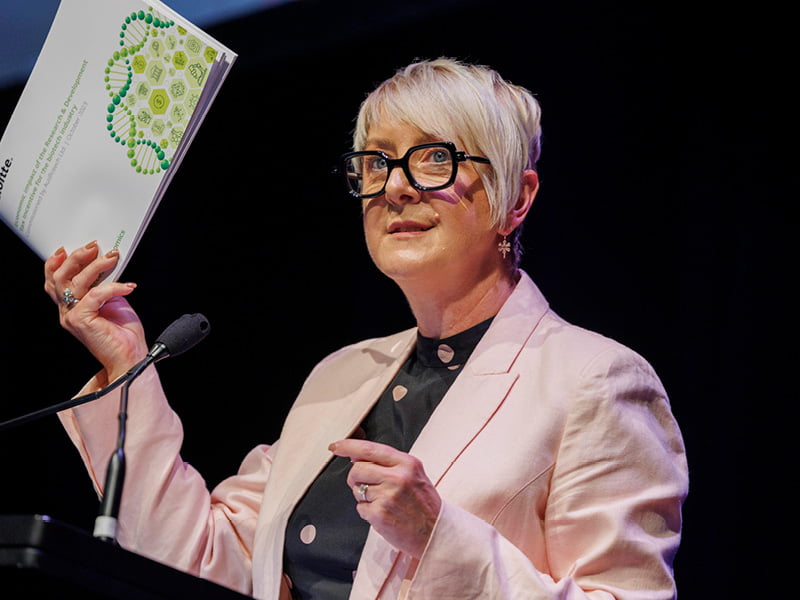More than a decade after its introduction, the research and development tax incentive has been “life-changing” for Australia’s biotech industry and an example of how effective long-term consistent policy can be, according to AusBiotech chief executive Lorraine Chiroiu.
A report commissioned by AusBiotech and completed by Deloitte Access Economics has found that for every $1 of foregone tax revenue from biotechs accessing the federal government’s research and development tax incentive (RDTI) in 2021, a return of $3.14 was generated.
It’s a lesson in how pivotal a role government policy levers can have in nurturing and growing a local industry, and the importance of maintaining consistency across election cycles, Ms Chiroiu said.

“There’s a story here that’s very important around long-term commitment to policy levers,” she said.
“We’ve always said that the right policy can be absolutely life-changing for industry, and for our lives more broadly. There’s a real need for consistency and reliability in government programming. There’s often this tension to change within government, and to develop new programs.
“This report gives some insight into the fact that knee-jerk changes are not good for anyone, particularly for the economy.”
The RDTI was introduced by the federal government in 2011 to replace the research and development tax credit scheme. It is now the primary tax initiative used by the government to encourage businesses to conduct research and development (R&D) in Australia.
The scheme allows eligible businesses to offset some of the costs of conducting R&D, with a refundable offset for companies with annual turnover of less than $20 million and the non-refundable offset for larger entities.
After a series of changes and reforms which came to a head in 2019, the RDTI has been relatively consistent across recent years.
The new research found that the benefit of the RDTI for biotech companies has increasingly grown over the last decade. In 2011 the RDTI for biotech increased GDP by $308 million. By 2021 it had increased GDP by $1.6 billion, an increase of more than five times.
The report found that the RDTI has been especially important for the Australia biotech sector, which often sees small or medium-sized companies conducting many years of research and development before beginning to commercialise a product.
“It’s an interesting story about innovation policy success,” Deloitte Access Economics partner John O’Mahony said.
“Most innovation policy discussion in Australia starts with a tone of concern about low rates of R&D spend, falling rates of spend and a sense that Australia is not doing enough, needs to do more to catch up and that an opportunity is passing us by.
“This report is quite different and corrects that tone for part of the policy and part of the industry landscape.”
It’s also further proof that the government should continue supporting the industry through the RDTI and look to introduce similar policy levers that can provide consistency over the coming decades, Ms Chiroiu said.
“[The report] proves what we’ve been saying, that it is providing significant value back to the country, and that it’s really important that it be continued,” she said.
“We’re really pleased that it has demonstrated that it’s working and there’s greater value over time, and that the government should continue to be dedicated to it.”
Ms Chiroiu said the decade of growth and its trajectory means the returns for biotech companies from the RDTI will be greater and greater.
“It’s adding to the critical mass that’s really taking hold in our country,” she said.
Overall, across the first decade of the RDTI, the scheme generated $2.18 for every dollar of foregone tax revenue to the Australian economy.
The major change in 2011 was allowing pre-revenue companies to access the offsets, a crucial difference for the biotech sector, Mr O’Mahony said.
“Biotech is an emerging industry in Australia, so a significant driver of growth is the creation of new firms with new innovations that are often risky endeavours, and the commercial benefits arrive in the longer term,” he said.
“There can be a big time lag between investment in R&D and the ultimate returns.”
The Australian biotech industry is now made up of more than 1400 companies, and it employs over 260,000 people. Within the sector, 178 companies are listed on the ASX, with a combined market capitalisation of $255 billion.
The large bulk of these companies — about 80 per cent — are SMEs, and the majority are pre-revenue and pre-market.
These companies have significantly higher R&D intensities than most of the rest of the economy, making the RDTI even more important. For small biotech companies, the average ratio of R&D expenditure to revenue in 2022 was about 43 per cent.
This article was produced by InnovationAus.com in partnership with AusBiotech.
Do you know more? Contact James Riley via Email.
